2021 Aprilia RSV4 and RSV4 Factory Review - First Ride

Just getting better with age.
Laguna Seca’s most prominent feature is the world-famous Corkscrew – the undulating left-right flick that you enter blind, which then proceeds to drop you three stories as you plunge into Rainey Curve. It’s a thrilling piece of asphalt every motorsport enthusiast should experience someday. But one of the more underappreciated sections of the track, especially for motorcyclists, is the hill leading up to the Corkscrew. Tackling it aboard the updated 2021 Aprilia RSV4 really makes you feel alive.
2021 Aprilia RSV4
| Engine | 19.0/20 |
| Suspension/Handling | 14.0/15 |
| Transmission/Clutch | 10.0/10 |
| Brakes | 9.0/10 |
| Instruments/Controls | 4.0/5 |
| Ergonomics/Comfort | 9.0/10 |
| Appearance/Quality | 9.5/10 |
| Desirability | 9.0/10 |
| Value | 7.0/10 |
| Overall Score | 90.5/100 |
After nailing the left-hand dip in Turn 6, momentum carries you out towards the curbing. With eyes now pointed up the hill, some heavy-handed persuasion from the throttle hand starts the drive up. With a bigger engine than before, the 1099cc V4 is howling its sweet song while painting squiggly lines on the ground with the Pirelli Diablo Supercorsa SP rear tire. That short section is a thrill ride on most bikes, but the audible – and visceral – experience of railing the new RSV4 through there reminded me how good the RSV4 is, and how good it’s always been.
What’s Changed?
The story of the 2021 Aprilia RSV4 and RSV4 Factory continues the same trajectory it’s been on since its introduction in 2009 – evolution over revolution. Let’s start by looking at the outside. As you glance at the new RSV4, it carries that same design architecture it always has. You know it’s an RSV4, but it’s… different. If the RSV4 looks similar to the RS660, that’s because it should. The 660 platform is the direction Aprilia is going with its design, so it only made sense for the RSV4 to align.
The triple LED headlamp arrangement has been reworked a little, but is still fundamentally Aprilia. Wings haven’t gone anywhere on the new RSV4, but their integration is different than on the previous RSV4 1100 Factory, resembling more traditional wings from the front while still being integrated into the design of the bodywork. From the cockpit it’s hard to make out the new wings, but aside from adding downforce to the front, the design of the front fairing is supposed to draw away hot air from the engine and direct it away from the rider.
Overall, the front fairing shape is a little wider, which Aprilia says reduces the total air pressure on the rider’s upper body by 11% compared to the previous model, while at the same time increasing air pressure at the airbox by 7%. Other changes include a slimmer fuel tank with a lower, slightly narrower profile. This combined with the lower seat height and lower pegs (max lean angle has actually increased 1.5 degrees) allows the rider to get into a better tuck and get under the bubble better. This assumes, of course, that you’re a jockey-sized motorcycle rider.
Eagle-eyed scouts who are familiar with the RSV4 will also notice another visual difference – the swingarm. This new version is braced from below, whereas previous models had the bracing above. The inspiration for this comes from the RS-GP MotoGP bike, but it also results in three main parts instead of the seven before, giving a 600g weight reduction and 30% more stiffness.
New Engine and Electronics
What about that V4 engine, you ask? Of course there are updates, spurred primarily because of pending Euro 5 regulations. Every manufacturer has had to do something to meet the rules, and in Aprilia’s case, a revised exhaust system was an obvious no-brainer. At the same time, Aprilia decided to give the RSV4 engine an increase in stroke by 1mm, from 52.3mm to 53.3mm, to make it a true 1099cc (bore stays the same at 81mm). A new, lighter-weight crankshaft lets the engine spin a little quicker, too.
The result is the same 217 hp as before, but torque gets a small increase from 90 lb-ft up to 92 lb-ft at 10,500 rpm. More importantly, you get 80% of max torque at 6800 rpm. Between 4000 and 8000 rpm there’s significantly more torque than the outgoing model.
All of this power is managed by an updated APRC system with the latest generation Marelli 11MP ECU that’s four times faster than the 75M ECU used before. This allows all of the bike’s rider aids to be even more sharp and precise than before, including the traction control, wheelie control, launch control, and the new engine brake control – all of which take advantage of the IMU’s capabilities. There’s even an updated Hall sensor in the quickshifter for cleaner shifts in either direction without the clutch. All of the bike’s functions are monitored via a new five-inch TFT display.
RSV4 Factory
Unlike in years past, the two available models have very easy names to remember. The base version is the RSV4. That’s it. The up-spec version is the RSV4 Factory, with the only difference being Öhlins Smart EC 2.0 electronic suspension, forged wheels, and dedicated color options. (Sachs analog suspension is on the standard model)
Riding Impressions
The opening paragraphs to this review should have clued you in to my initial thoughts about the RSV4. Long-time readers will also have a good idea where I stand, too. Since the beginning, the RSV4 has been a universally loved motorcycle, praised for its confidence-inspiring handling and that beautiful V4 sound. Through the years, and through various increases in engine size and electronic updates, the RSV4 has been the poster child for success in the literbike class through constant refinement. This new one is no different.
Familiarity is the first impression I get after just a couple turns around Laguna Seca. Like getting reacquainted with an old friend, only this time an old friend who’s decided to hit the gym and make good on their new year’s resolutions. Ripping around Laguna, the small bump in torque results in power wheelies when coming out of the tight turn 11 onto the front straight, but the wheelie control makes sure the front wheel gently comes up, then gently comes back down again.
You’re picking up serious speed by the time you’re cresting the wild turn 1 hill before on the brakes hard for the tight turn 2. All the while your left foot is dancing all over the shifter, and every time the next cog is clicked nice and clean with the improved quickshifter. Power delivery is as smooth as it’s ever been, but for the tight confines of Laguna, engine map 2 (of 3) smoothed the power out just a hair more to my liking. Level 1 was slightly too aggressive for my taste around a tight track, but if this were, say, Mugello, it might be my preferred setting. All three engine maps give full power, with the difference being the immediacy in which it’s delivered. Of course, you have different riding modes – six total, three street settings and three track settings, with one setting in each being completely customizable.
It shouldn’t be surprising to hear the RSV4 is a fast and powerful motorcycle. You come to expect that with sportbikes of this caliber. Being an RSV4, you expect it to handle nicely, too. And it does. The bike feels stable and confident leaned over, and despite it’s heft (Aprilia says 445 lbs with the fuel tank 90% full), it carries its weight well. Like it always has.
For me, the surprise I wasn’t expecting was from the ergonomic changes. The lower seat height is noticeable, even for someone who hasn’t been on an RSV4 in ages like myself. Combined with the lower-profile tank and lower pegs, getting into the bubble felt very natural and comfortable. As far as sportbikes go, I like the way this one fits.
Which is good, because our ride day was cold and damp. Not ideal riding conditions, especially with Pirelli Diablo Supercorsa SP street tires without warmers. But it’s that comfort on the bike that made it easy enough to spin some warm-up laps before riding hard. The feedback from the tires all the way through to the bars let me know in incremental steps if the rubber was ready to go faster. With the Aprilia Traction Control switched to level 4 (of 8), there would be a safety net there in case my right hand got a little overzealous. When it did, the intervention was noticeable, but not annoyingly so – Aprilia has done a good job dialing in the electronics to be as unobstructive as possible. Of course, I could have lowered the TC setting further, but with the sketchy conditions we were facing, self-preservation triumphed over bravery.
The RSV4 has always been a fine-handling motorcycle, and this latest version continues the tradition. I’ve long been a fan of its stability under braking and the confidence it inspires when fully leaned over. It’s a precise chassis, allowing you to put the bike exactly where you want it, time after time. The new swingarm design is said to be stiffer, but without an older one to try back-to-back, it really is next to impossible to tell. Nonetheless, there’s still all of the magic that has made the RSV4 a fan favorite.
What about the wings, you ask? Honestly, I couldn’t tell you. Laguna Seca isn’t a high-speed track, and as you can probably guess, without a non-winged version it’s hard to make any comparisons. But hey, at least they’re big enough you can place your water bottle on it when you’re done riding and popping off your helmet!
Factory
Up to this point, the impressions I’ve given can relate to both bikes, but as we know, the Factory version comes with electronic suspension and forged wheels. The difference the forged wheels make is marginal, but they’re nice touches to have.
As for the electronic suspension, it does its job well – which is a detriment on track. The benefit of electronic suspension is the ability to adjust to changing conditions. This is great for road riding, where the pavement could throw up curve balls at any moment. On track, however, the conditions are the same lap after lap. Meanwhile, the suspension is always making minute changes to account for one data point or another. The result is an inconsistency in feedback (a minor one, mind you) even though you’re covering the same piece of pavement.
On the bright side, toggling through the menus and changing the bike’s attitude (instead of changing digital compression or rebound “clicks,” which you can also do) at the push of a button is relatively easy, and likely to benefit the occasional track rider who may not be as consistent with their lines or confident with their suspension setup on analog forks and shocks.
Closing Thoughts
Which brings us to some closing thoughts on the 2021 Aprilia RSV4 and RSV4 Factory. In short, the magic that has always been there hasn’t left. Style is subjective, of course, but I imagine RSV4 fans likely aren’t too disturbed by the new looks. What you can’t argue is the bigger engine and improved electronics are a step up from before. The power is a thrill, the electronic rider aids are top-notch, and the sound – oh the sound – is as sweet as ever. When paired with one of the most iconic chassis ever equipped on a motorcycle, you have a hard time faulting it.
However, if it were me, I’d likely opt for the standard version and skip the electronic suspension and forged wheels. The analog bits work just fine and give the feedback I want. Best of all, it costs less, too. Standard models wear a price tag of $18,999 while Factory models will set you back $25,999. No matter what you choose, the RSV4 is proof that if it ain’t broke, there’s no need to fix it.
2021 Aprilia RSV4/RSV4 Factory
+ Highs
- The V4 engine is bigger and badder than ever
- An electronics suite that’s always been great
- Better ergos (at least for small folks)
– Sighs
- The Factory’s electronic suspension is best for the street
- No more 999cc version, if you care about such things
- Where could the RSV4 possibly go from here?
In Gear

Helmet: 6D ATS-1R Aero $550
- Leathers: Alpinestars GP Pro V2 1pc Suit Tech-Air Compatible $1300
- Airbag: Alpinestars Tech-Air Race Vest $1150
- Gloves: Alpinestars GP Pro V3 Gloves $260
Boots: Alpinestars Supertech-R Boots $450
2021 Aprilia RSV4/RSV4 Factory Specifications | |
|---|---|
| MSRP | $18,999/$25,999 |
| Engine Type | 1099cc liquid-cooled 65º V4, DOHC, four valves per cylinder, airbox with front dynamic air intakes. 4 Marelli 48-mm throttle bodies with 8 injectors and Ride-By-Wire engine management. |
| Bore and Stroke | 81.0mm x 53.3mm |
| Compression Ratio | 13.6:1 |
| Horsepower (claimed at crankshaft) | 217 hp @ 13,000 rpm |
| Torque (claimed) | 92.2 lb-ft (125 Nm) @ 10,500 rpm |
| Transmission | 6-speed cassette type gearbox Gear lever with Aprilia Quick Shift electronic system (AQS) |
| Final Drive | Chain |
| Front Suspension | Sachs fork, 43 stanchions, adjustable compression and rebound, travel 127 mm/Smart EC 2.0 electronically managed Öhlins NIX fork. 43 mm stanchions, with TIN surface treatment Aluminium radial caliper mounts, adjustable in hydraulic compression and rebound damping and spring pre-load, 125 mm travel |
| Rear Suspension | Sachs monoshock adjustable in: hydraulic compression and rebound damping and spring pre-load, 130 mm travel/Upside-down double-braced aluminum swingarm; Öhlins TTX monoshock with Smart EC 2.0 electronically managed piggyback, fully adjustable in: spring pre-load, wheelbase, and hydraulic compression and rebound damping. 115 mm travel |
| Front Brake | Dual 330-mm diameter floating stainless steel disc with lightweight stainless steel rotor and aluminum flange with 6 pins. Brembo Stylema monobloc radial calipers with 4 30 mm opposing pistons. Sintered pads. Radial pump and metal braided brake hose |
| Rear Brake | 220 mm diameter disc; Brembo calliper with two 32 mm separate pistons. Sintered pads. Pump with integrated tank and metal braided hose Bosch ABS with cornering function and 3 map settings, equipped with RLM (Rear wheel Lift-up Mitigation) strategy |
| Front Tire | 120/70-17 |
| Rear Tire | 200/55 ZR 17 (alternative: 190/50 ZR 17; 190/55 ZR 17) |
| Rake | 24.6 deg |
| Wheelbase | 56.5 in. |
| Seat Height | 33.3 in. |
| Curb Weight (Measured) | 445 lbs. (with 90% fuel) |
| Fuel Capacity | 4.7 gal. |
| Colors | Dark Losail/Lava Red, Aprilia Black |
Become a Motorcycle.com insider. Get the latest motorcycle news first by subscribing to our newsletter here.

Troy's been riding motorcycles and writing about them since 2006, getting his start at Rider Magazine. From there, he moved to Sport Rider Magazine before finally landing at Motorcycle.com in 2011. A lifelong gearhead who didn't fully immerse himself in motorcycles until his teenage years, Troy's interests have always been in technology, performance, and going fast. Naturally, racing was the perfect avenue to combine all three. Troy has been racing nearly as long as he's been riding and has competed at the AMA national level. He's also won multiple club races throughout the country, culminating in a Utah Sport Bike Association championship in 2011. He has been invited as a guest instructor for the Yamaha Champions Riding School, and when he's not out riding, he's either wrenching on bikes or watching MotoGP.
More by Troy Siahaan



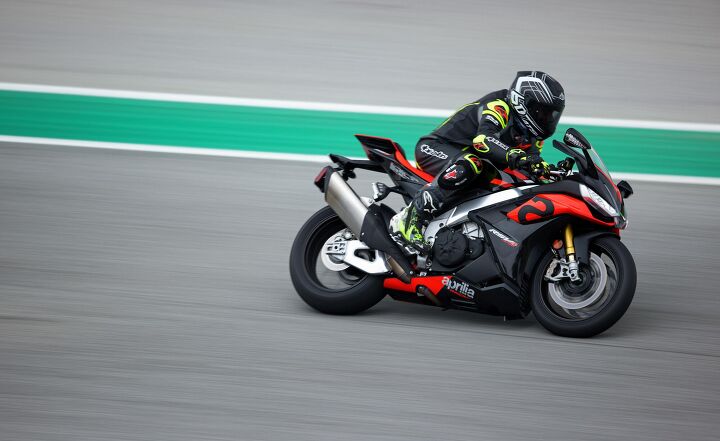
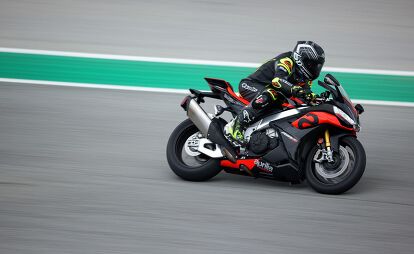



































































































































































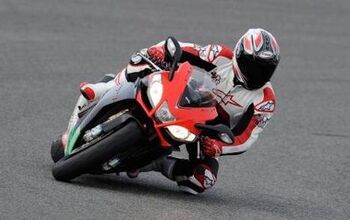
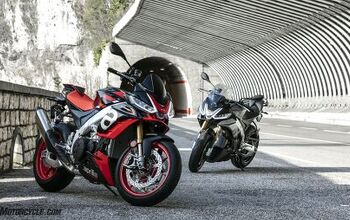
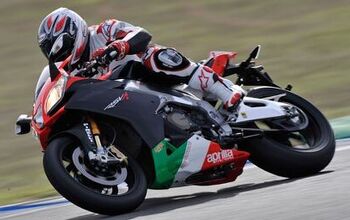













Comments
Join the conversation
Q. Where could the RSV4 possibly go from here?
From a couple of press releases from Aprilia personal ( paraphrasing) ' this is the last in the evolution of the rsv4 '
A. Ground up new model
Well, I'm probably too old for a sportbike at 51, but I just found a 21 RSV4 for $14,999! Talk about a smoking deal!